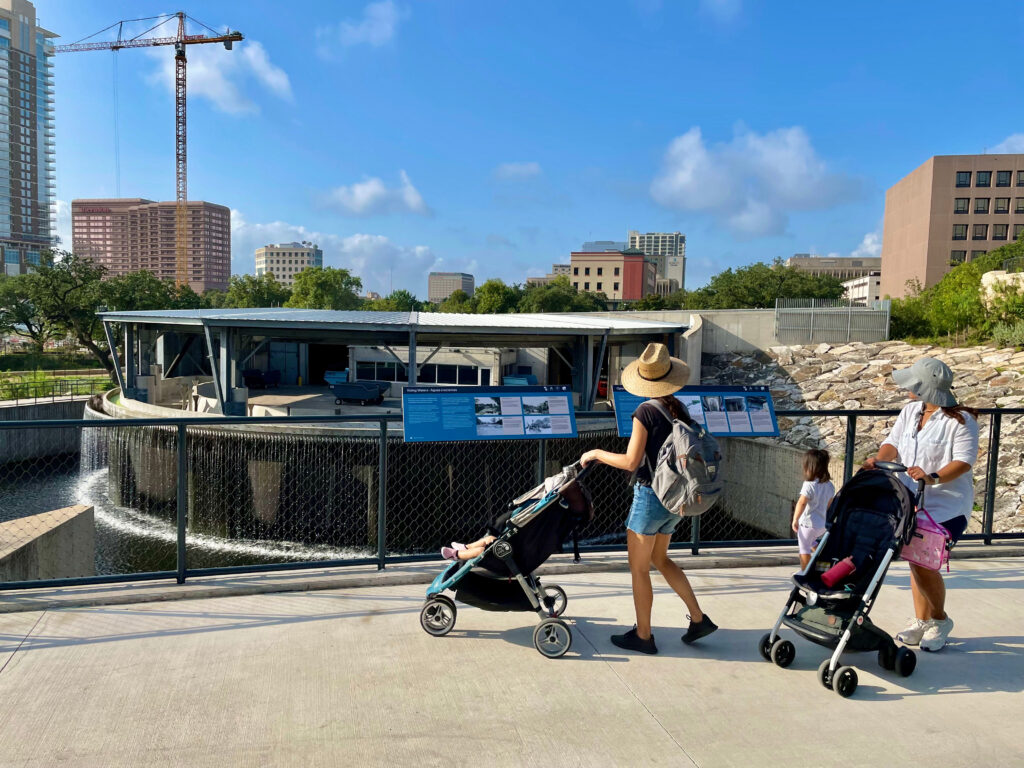History

Waterloo Greenway is a remarkable story that’s still unfolding — one filled with generations of diverse communities and unforgettable moments that shaped the landscape of Waller Creek. Today, the park binds this vital part of our city’s shared history together, while creating a brighter future for all.
The Waller Creek History Project was an effort undertaken by Waterloo Greenway in 2018 to help document the stories of the people who have lived, worked, and played in the area of our project through archival research, photography collection, and oral histories. This history helps inform the future of these spaces, while helping us honor and hold space for the stories of our community. Read on below to view a historical timeline snapshot — more detailed information can be found in our History Report. We know there are always many more stories to be told, so please feel free to share other stories with our team at info@waterloogreenway.org.
While you are visiting Waterloo Park, you can learn more about the park’s history in person too, featured on signage in many areas. We also offer an interactive chatbot program, that shares fun facts by text during your visit!
Pre- to Mid-1800s
Earliest Residents
For over 15,000 years, Indigenous Peoples had their own relationship with this landscape. Generations occupied the Waller Creek area long before it bore that name, including the Coahuiltecans, Lipan Apache, Tonkawa, and Comanche Tribes. Local waters represented a spiritual connection, home to many sacred traditions. Eventually, European settlement into Texas forced most Indigenous Peoples to go underground and identify as “Mexican” in order to stay in their ancestral lands.
An Emerging City
Labeled “Austin’s Spring Creek” in an 1838 map, Waller Creek soon finds itself in the heart of American history. In 1839, the neighboring town of Waterloo becomes the capital of the new Republic of Texas. A new city rises quickly, changing its name to Austin. Before our community was named “Austin,” it was known as “Waterloo.”
Growth Through Diversity
In the 1840s, German and Swedish immigrants settle on Waller Creek. They establish some of the first businesses in the area. After enduring enslavement, recently freed African Americans created a community here along the banks of Waller Creek. Sometimes called the “Red River Community,” these families lived in and around the land that is today Waterloo Park. Mexican and Lebanese immigrants fleeing political unrest arrive a few decades later.
1900 – ‘10s
City Connector
The community along Waller Creek – sometimes called the “Red River Community” – thrives as an important transitional area between Neches and Trinity Streets and East Avenue. It connects downtown Austin to the west and Robertson Hill to the east. A large African-American population interspersed with white and Mexican immigrant households contributes widely to the area’s growth and vibrancy.
1915 Flash Floods
In 1915, flash floods kill as many as 50 people in Austin, including 12 along Waller Creek. A 1915 article in the Austin American-Statesman reads: “Whole sections of the city were submerged for hours. Houses were washed away, cows, horses, chickens and other fowls were careening down swelled Shoal and Waller Creeks … This morning Austin presents a pitiable sight.”
1920 – ‘30s
Business and Pleasure
By 1920, over 30 black-owned businesses serve the Waller Creek area. They stand shoulder to shoulder with the many grocery stores, shops, and restaurants run by Lebanese, German, Chinese, and Mexican-American neighbors. Throughout the roaring ’20s, newspaper articles show that swimming in Waller Creek is the favorite hot-day pastime for youth in the area.
A Community Unraveling
The Koch and Fowler 1928 City Plan presents the idea of picturesque parks and boulevards in the Waller Creek area. But the beautification plans also reinforce the racist Jim Crow policies. By the 1930s, segregation pushes many families out of the area, and their homes are demolished. Larger commercial enterprises move in, forcing long-standing small businesses to relocate or close their doors.
Creation of Palm Park
Through a bond program passed in 1928, the rechannelization of Waller Creek begins. So does the creation of Palm Park near the creek’s shores. The first iteration of the park takes shape adjacent to the Palm School, founded in 1892 as one of Austin’s first elementary schools. The “Palm School playground plan” – including two ball courts, two volleyball courts, two croquet courts, double tennis court, swimming pool, pergola, and brick gymnasium – opens May 29, 1933.
1940s
Palm Park Growth
Palm School and Palm Park play an important role in the life of the lower Waller Creek community in the 1940s. White and Mexican-American children frequent the park. But, for many years, only white children can swim in the park’s popular pool.
Interregional Highway
Planning of the Interregional Highway over East Avenue starts in the ’40s, and construction begins in the early 1950s. Thanks to improved roads and the introduction of the highway, a variety of news businesses pop up in the area. Many are auto‐related.
1950s–’60s
Development Projects
Federal programs aiding Interstate 35 construction also drive development projects that change the character of the Waller Creek corridor. The Federal Housing Act of 1949 included funding to demolish substandard properties to make room for public facilities. In 1968, the Brackenridge Urban Renewal Project north of 9th Street includes an addition to Brackenridge Hospital and the creation of a public space with two parts: Waterloo Park and Symphony Square.
Music Scene
In the 1950s and 1960s, Red River Street takes its place as the heart of Austin’s music scene. Early entertainment clubs reflect the diversity of the surrounding neighborhoods. Even as urban renewal transforms the area – now known as the Red River Cultural District – it continues to be a place of musical innovation and cultural expression.
Waller Creek Riot
In 1969, The University of Texas Board of Regents decides to bulldoze several hundred feet of Waller Creek along San Jacinto Boulevard to expand Memorial Stadium. On Oct. 22, student protesters chain themselves to trees in an unsuccessful attempt to stop the project. It becomes known as the Waller Creek Riot.
1970s
Waterloo Park
In the 1970s, six blocks of homes were condemned and their families displaced to make way for Waterloo Park and other urban renewal projects. The park opens in 1975, hosting scores of concerts, festivals, and events over the years.
Symphony Square
In April 1978, Symphony Square opens as a southeastward extension of Waterloo Park on both sides of E. 11th Street, east of Red River Street. The new headquarters of the Austin Symphony Orchestra, the Square is formed by four historic buildings: the Jeremiah Hamilton House (the only building original to the site), New Orleans Club, William P. Hardeman House, and Michael Doyle House. Read more about Symphony Square’s history.
Waller Creek Development Plan
In 1975, a joint venture of urban planners, architects, landscape architects, and engineers create the Waller Creek Development Plan. The plan proposes improvements to the Waller Creek corridor as part of the City of Austin’s U.S. Bicentennial project.
Palm School Closing
The construction of Interstate Highway 35 cuts Palm School off from the community it serves. When George I. Sanchez Elementary School opens on the east side of the highway in 1976, many students in neighborhoods east of IH-35 attend the new school. After almost two decades of falling into disrepair, Palm School closes in 1976. Learn more about the history of Palm School.
1980s–2000s
Juárez‐Lincoln University
The Mexican American Youth Organization votes to establish a southern Texas Chicano university in 1969 in the midst of a movement for much-needed advancement of the Chicano community. Juárez‐Lincoln University is born and eventually moves into the vacant East Avenue Baptist Church. The university closes in 1979, and the building sells in 1980. After community activists make several unsuccessful attempts to declare the property historic, the owners demolish it in 1983, strongly impacting the Mexican-American community.
Mexican American Cultural Center
In the early 1970s, community members ask the City of Austin to establish a cultural facility that honors the Latino community and reflects the historic Rainey Street neighborhood. After unsuccessful efforts in the late 1980s and 1990s, the Emma S. Barrientos Mexican American Cultural Center finally comes to life in June 2007, neighboring Waller Creek.
Austin Convention Center
In the 1990s, lower Waller Creek sees construction of the Austin Convention Center on what was then E. 1st Street. In recognition of the significant Mexican-American community that once lived in the area, the City of Austin renames this main thoroughfare César Chávez Street in 1993.
Waller Creek’s Potential
On Nov. 6, 1997, the Austin City Council passes a resolution to discuss the potential benefits of Waller Creek with the public institutions and private interests that share responsibility for it.
A Vision for Waterloo Greenway
Waterloo Greenway
The City of Austin had a vision for transforming the neglected Waller Creek area into a connected, inclusive, and vibrant public park that could benefit the entire Austin community. In collaboration with the city, Melba Whatley, Melanie Barnes, and Tom Meredith founded the Waller Creek Conservancy in 2010. Today, both the Conservancy and all of the park’s many destinations are collectively known as “Waterloo Greenway.” Learn more about the Conservancy and the progress it has made in connecting all of the people in our vibrant city to nature, art, culture, and to each other.
